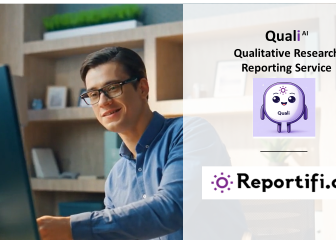
Introduction: Effective communication and presentation of research findings are crucial for ensuring that insights are understood, valued, and acted upon. After gathering rich qualitative data, the challenge lies in distilling and presenting these insights in a way that aligns with research objectives and drives meaningful action. In this post, we’ll explore strategies for summarizing findings, uncovering true insights, and how tools like Reportifi.ai QualiAI can streamline the creation of impactful report slides.
Understanding Your Audience
Before summarizing your findings, it’s important to know who will be receiving the information. This includes identifying stakeholders, understanding their specific needs, and determining their knowledge level about the topic. Tailoring your communication to meet the needs of your audience ensures that your message resonates and is actionable.
- Identify Stakeholders: Consider who will be using the findings—executives, campaign teams, analysts, or media outlets. Each group may require a different level of detail and focus.
- Understand Their Needs: What are they looking to learn from the research? Are they interested in broad trends, specific voter concerns, or detailed policy comparisons?
- Determine Knowledge Level: Gauge how familiar your audience is with the election landscape. This will guide how much background information and context you need to provide.
Summarizing Findings Aligned to Research Objectives
Aligning your summary to the research objectives ensures that the most relevant and actionable insights are highlighted. Here’s how you can structure your summary:
- Restate the Objectives:
- Begin by revisiting the research objectives. Be specific with your objectives and identify all of the objectives the research is scoped for.
- Organize by Themes:
- Group your findings by themes that emerged during the research. For instance, if multiple respondents mentioned healthcare as a critical issue, create a section dedicated to healthcare-related insights.
- Highlight Key Findings:
- For each objective, identify the most significant findings. These are the insights that directly answer your research questions and have the potential to impact decision-making.
- Use Supporting Quotes:
- Incorporate direct quotes from respondents to add depth and authenticity to your summary. Quotes can illustrate the emotional drivers behind voter decisions and provide context to the findings.
- Provide Context:
- Explain the context behind the findings. For example, if voters expressed skepticism about a candidate, clarify whether this sentiment was widespread or limited to a particular demographic.
- Conclude with Actionable Insights:
- End each section with actionable insights that align with the objectives. For instance, if voters are concerned about healthcare, recommend strategies for addressing these concerns in campaign messaging.
Uncovering True Insights
True insights go beyond surface-level observations to reveal underlying motivations, beliefs, and emotional drivers. Here’s how to uncover and present these deeper insights:
- Look for Patterns and Trends:
- Analyze your qualitative data for recurring themes, patterns, and trends. This might involve identifying common concerns, shared values, or consistent reactions to certain policies.
- Ask the “Why” Behind the “What”:
- Use probing questions during analysis to understand why respondents feel the way they do. For example, if voters express distrust in a candidate, explore the reasons behind this sentiment.
- Synthesize Multiple Data Points:
- Combine insights from different data sources (e.g., interviews, focus groups, ethnographic studies) to create a more comprehensive picture. Cross-referencing data can validate findings and reveal deeper truths.
- Identify Contradictions and Outliers:
- Pay attention to contradictions or outlier opinions. These can provide unique insights or indicate areas where further investigation is needed.
- Relate Findings to Broader Context:
- Place your insights within the broader context of the election and societal trends. This helps stakeholders understand the implications of the findings beyond the immediate research.
Creating Impactful Report Slides with Reportifi.ai Quali
Once you’ve distilled your findings into clear insights, the next step is presenting them effectively. Reportifi.ai QualiAI is designed to streamline this process by helping you create professional, visually compelling report slides.
- Automated Slide Creation:
- QualiAI can automatically generate slides based on your summarized findings, saving time and ensuring consistency in formatting and style.
- Visualizing Data:
- QualiAI report slides provide space to incorporate data visualizations that enhance understanding. Use images, charts, graphs, and word clouds to highlight key trends and insights.
- Executive Summaries:
- Quickly create executive summaries that distill the most important insights into a concise, easy-to-read format. This is ideal for time-pressed stakeholders who need to grasp the key points at a glance.
- Interactive Elements:
- For presentations, QualiAI allows you to add interactive elements, such as clickable sections or embedded videos, to engage your audience and make the findings more dynamic.
- QualiAI enables you to incorporate data visualizations that enhance understanding. Use charts, graphs, and word clouds to highlight key trends and insights.
Learn more about QualiAI here.
Continuous Improvement in Communication
Effective communication is an ongoing process that benefits from regular refinement:
- Seek Feedback: After each presentation or report, gather feedback from your audience to understand what worked and what didn’t.
- Stay Updated: Keep abreast of new tools, technologies, and best practices in data visualization and report writing.
- Practice Regularly: Continually practice your presentation skills to build confidence and improve delivery.
- Collaborate: Work closely with colleagues to review and refine your findings and presentation materials.
Conclusion
Summarizing qualitative research findings in alignment with your objectives and uncovering true insights are essential steps in transforming raw data into actionable strategies. By effectively communicating these insights and utilizing tools like Reportifi.ai Quali, you can create impactful presentations and reports that drive informed decision-making and business success. Continuous improvement in your communication skills will further enhance the impact of your research efforts, ensuring that your findings not only resonate but also lead to meaningful action.



